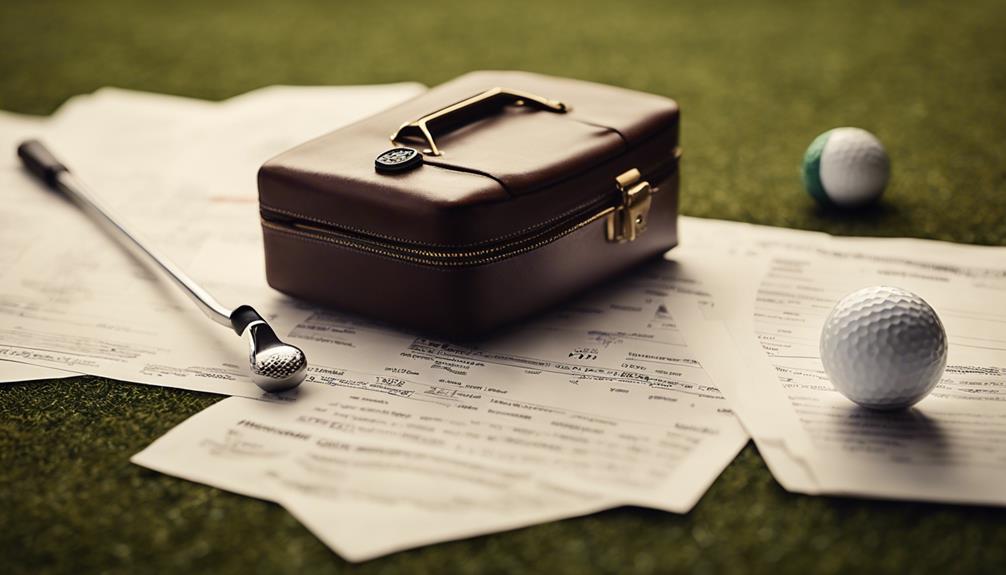- 7 Top Flite Golf Clubs XL for Improved Performance - September 28, 2024
- Top Flite Golf Clubs: Top 5 Reasons to Choose Them - September 28, 2024
- Top 3 Golf Club Fitters for a Perfect Swing - September 28, 2024
As a golf club operator, you need to understand that green fees are exempt from Value-Added Tax (VAT), but this exemption doesn't apply to all aspects of your business. Not-for-profit golf clubs can claim a significant VAT rebate on green fees and subscriptions, but claims must comply with HMRC guidance to qualify. Membership subscriptions, on the other hand, are subject to the standard rate of VAT, unless they're focused on social activities. To maintain compliance and maximize VAT recovery, you'll need to accurately track income streams, expenses, and VAT calculations. You'll have to examine the nuances of VAT exemptions and rebates to optimize your club's financial position.
Key Takeaways
- Not-for-profit golf clubs are entitled to claim a significant VAT rebate on green fees and subscriptions due to an ECJ ruling.
- Green fees are exempt from VAT, but tour operator income from green fees is taxable, and the exemption only applies to not-for-profit golf clubs.
- Membership subscriptions are subject to the standard rate of VAT, but some social-focused subscriptions may be eligible for VAT exemption.
- VAT exemption applies to membership subscriptions, but other income streams are subject to VAT at the standard rate, requiring partial exemption methods.
- For-profit golf courses do not qualify for VAT exemption, unlike not-for-profit golf clubs, which can claim a rebate on certain VAT payments.
VAT Exemption Rules
When determining VAT exemption, golf clubs must carefully navigate the complex rules governing their various income streams, as incorrect classification can lead to costly errors and penalties.
You need to understand that green fees are exempt from VAT, while tour operator income from green fees is taxable. Additionally, bar and catering income is also subject to VAT.
The VAT exemption applies to taking part in sport and physical education in general, which is a vital aspect.
As a golf club, you should be aware that member states can't differentiate between recipients of identical services, leading to a substantial VAT rebate for not-for-profit golf clubs.
To accurately classify your income streams and expenses, you must correctly identify them. This will help you avoid costly mistakes and penalties.
Golf Club Memberships
You must carefully distinguish between different types of golf club memberships, as their VAT treatment varies substantially.
When it comes to membership subscriptions, you'll find that the standard rate of VAT applies to most of them. This means that golf clubs must charge VAT on membership fees, which can include annual subscriptions, initiation fees, and other recurring charges.
However, there are some exceptions to this rule. For instance, if a golf club offers a membership that's primarily focused on social activities, such as dining or events, rather than playing golf, it may be eligible for VAT exemption.
It's essential to properly categorize each type of membership to guarantee accurate VAT treatment. You should review your membership agreements and terms to determine which ones qualify for exemption and which ones are subject to the standard VAT rate.
Remember, incorrect VAT application can lead to costly penalties and fines.
By understanding the nuances of VAT treatment for golf club memberships, you can confirm compliance and avoid potential pitfalls.
Capital Expenditure Implications

Golf clubs undertaking significant capital expenditure on course redevelopment works or clubhouse extensions and refurbishments must navigate complex VAT regulations to optimize VAT recovery and avoid costly penalties.
You'll need specialist VAT advice to determine if a Partial Exemption Special Method would be beneficial and if the 'Option to Tax' would provide a more favourable VAT profile. Early planning is essential to optimize VAT recovery on capital expenditure, and a specialist VAT advisor can guide you through this process.
Capital spend exceeding £250,000 (net of VAT) requires measuring taxable use of the asset over a 10-year period under the Capital Goods Scheme.
You'll need to make adjustments to initial input VAT recovery each year where appropriate, and precise tracking of taxable use and input VAT recovery is vital to avoid VAT penalties and interest. Failure to examine VAT implications can result in lost opportunities for VAT recovery.
VAT on Subscriptions
VAT exemption on membership subscriptions and visitor green fees, as established in the Bridport & West Dorset Golf Club case, creates a complex VAT landscape for golf clubs, requiring careful management of mixed income streams.
VAT exemption applies to your membership subscriptions, but other income streams, such as catering, retail, and corporate group rounds of golf, are subject to VAT at the standard rate.
This mix of exempt and taxable income requires the use of a partial exemption method to calculate recoverable input tax on associated costs. You can use the standard income-based method or a special method agreed with HMRC for partial exemption.
Accurate calculation of recoverable input tax is vital to avoid VAT compliance issues. You'll need to verify you're accurately tracking and allocating your costs in order to take advantage of the VAT exemption on your membership subscriptions.
Loan and Levy Considerations

When considering loan and levy options for your golf club, you'll need to examine the fine print of lease agreement terms, as they can substantially impact your VAT liability.
You'll also want to assess how interest rates affect your club's tax situation, ensuring you're not inadvertently shifting tax liability.
Lease Agreement Terms
As you negotiate a lease agreement for VAT-exempt golf clubs, verify that you thoroughly review the terms governing loans and levies to guarantee a thorough understanding of your financial obligations. This scrutiny is vital, as it directly impacts your business's bottom line.
When examining the lease agreement, pay close attention to the following key aspects:
Loan duration and repayment terms: Confirm you comprehend the loan's length, interest rates, and repayment schedule to avoid unexpected costs.
Levy structures and calculations: Verify the methodology used to determine levies, including any potential penalties or fees.
Asset ownership and maintenance: Clarify who retains ownership of the golf clubs and who's responsible for maintenance, repairs, and upgrades.
Insurance and risk management: Determine who bears the risk of loss, damage, or theft, and what insurance coverage is required.
Termination and renewal clauses: Understand the conditions for terminating or renewing the lease agreement, including any associated costs or penalties.
Interest Rate Impacts
Examining the interest rates attached to your loan and levy structures is essential, since even slight changes can substantially impact your overall financial burden. As a golf club owner, you must consider the interest rate implications of your loan and levy agreements to avoid overcommitting financially.
| Interest Rate Scenario | Financial Impact |
|---|---|
| 3% interest rate on a £500,000 loan | £15,000 annual interest payment |
| 4% interest rate on a £500,000 loan | £20,000 annual interest payment |
| 5% interest rate on a £500,000 loan | £25,000 annual interest payment |
As the table illustrates, a 1% or 2% increase in interest rate can result in significant annual interest payments. This can be particularly challenging for golf clubs with already tight financial margins. When negotiating loan and levy agreements, it's vital to carefully evaluate the interest rates and consider the long-term implications on your club's financial sustainability. By doing so, you can make informed decisions that minimize your financial burden and guarantee the continued success of your golf club.
Tax Liability Shift
You'll need to weigh the tax implications of your loan and levy agreements, since a shift in tax liability can substantially impact your golf club's financial standing. A tax liability shift can occur when the responsibility for paying VAT on goods and services is transferred from one party to another. This can happen when you enter into loan or levy agreements with suppliers, members, or other stakeholders.
To navigate these complexities, consider the following key factors:
- Identify the VAT treatment of each loan and levy agreement: Verify that you understand who's responsible for paying VAT on each transaction.
- Determine the VAT rate applicable to each agreement: Confirm the correct VAT rate for each loan and levy agreement to avoid errors.
- Assess the impact of VAT on your cash flow: Calculate how VAT payments will affect your golf club's cash flow and budget.
- Review your accounting and record-keeping processes: Confirm that your systems can accurately track and report VAT payments and liabilities.
- Seek professional advice when needed: Consult with a tax expert or accountant if you're unsure about any aspect of VAT liability or compliance.
Hire of Rooms and Facilities
When you're managing a golf club, understanding the VAT implications of hiring out rooms and facilities to non-members is crucial.
Specifically, when golf clubs hire out rooms and facilities to non-members, they must account for VAT on these supplies. This is because such hires are considered taxable supplies, and the club is required to charge VAT at the standard rate.
You'll need to determine the VAT liability of each hire, considering factors like the type of room or facility, the duration of the hire, and the identity of the hirer. Keep in mind that VAT exemptions don't apply to these supplies, so you can't zero-rate them.
As the golf club, you're responsible for maintaining accurate records of all hires, including the VAT charged and accounted for. This verifies you can accurately report VAT on your VAT return and make timely payments to HMRC.
Non-Profit Making Status

As a not-for-profit golf club, you're entitled to claim a significant VAT rebate, thanks to a landmark European Court of Justice (ECJ) ruling that levels the playing field for sports clubs. This ruling has far-reaching implications for non-profit making bodies like yours, allowing you to reclaim a substantial portion of VAT paid on green fees and subscriptions.
- You can claim a VAT rebate of 50% or 33% of claimed sums, depending on green fees charged, if claims comply with HMRC guidance.
- The VAT exemption applies to taking part in sport and physical education in general, and member states can't differentiate between recipients of identical services.
- The ECJ ruling can be backdated for at least four years, leading to a substantial VAT rebate for not-for-profit golf clubs.
- The exemption only applies to not-for-profit golf clubs, not for-profit courses, which must levy VAT on subscriptions and green fees.
- HMRC has issued a VAT Brief on unjust enrichment refunds and not-for-profit sports clubs, providing guidance on the refund process.
Partial Exemption Implications
Claiming a VAT rebate under the ECJ ruling can have significant partial exemption implications, potentially affecting your golf club's overall VAT recovery position.
As you navigate the complexities of VAT exemption, it is vital to bear in mind the partial exemption method your club uses to apportion VAT between taxable and exempt supplies. When you claim a VAT rebate, you'll need to reassess your partial exemption calculations to achieve accuracy and compliance.
This may involve revisiting your club's VAT recovery rate, which could be affected by the rebate claim. You'll need to weigh the impact of the rebate on your club's overall VAT liability, verifying that you're not over- or under-recovering VAT.
Additionally, you should review your club's accounting systems to accommodate the changes resulting from the rebate claim. By doing so, you'll be able to maintain an accurate partial exemption calculation and avoid potential VAT disputes with HMRC.
Key to maintaining your golf club's VAT recovery position is carefully evaluating these implications to guarantee your club's VAT recovery remains in the best possible state.
Compliance and Record Keeping

To guarantee compliance with HMRC regulations, you must maintain meticulous records of your golf club's income streams, expenses, and VAT calculations. Accurate record keeping is vital to verify you're meeting the necessary requirements and avoiding penalties and interest.
Maintain accurate and detailed records of your golf club's income streams, including membership fees, green fees, and other revenue sources.
Track expenses, including taxable, exempt, and partial expenses, to facilitate precise partial exemption calculations.
Keep records of input tax recovery, including VAT on capital goods and expenses eligible for VAT recovery.
Verify accurate calculation of recoverable VAT, including retrospective applications for VAT recovery on costs incurred during lockdown periods.
Retain records of Capital Goods Scheme calculations, including attributing VAT to taxable, exempt, and partial expenses.
Frequently Asked Questions
Do You Pay VAT on Golf?
When it comes to your golfing expenses, you don't pay VAT on green fees, but you do pay VAT on other expenses like buggy and trolley sales, as well as bar and catering services.
Do You Pay VAT on Gym Membership?
When you sign up for a gym membership, you typically don't pay VAT, as it's considered a service exempt from value-added tax; however, some Fitness Incentives, like personal training sessions, might be subject to VAT.
What Is Partial Exemption Vat?
You're likely aware that 40% of businesses struggle with VAT compliance; now, let's explore partial exemption VAT, a method used across various VAT Sectors, where businesses with mixed taxable and exempt income streams must accurately calculate recoverable input tax.
Conclusion
As you navigate the links of VAT exemption, remember that even the most skilled golfers can't avoid the hazards of misinterpreted rules.
Like finding the perfect swing, understanding VAT exemption for golf clubs requires precision and attention to detail.
By grasping the nuances of VAT exemption, you'll avoid costly penalties and guarantee your club stays on par with HMRC's regulations.
Stay vigilant, and your club will be driving down the fairway to financial stability.




